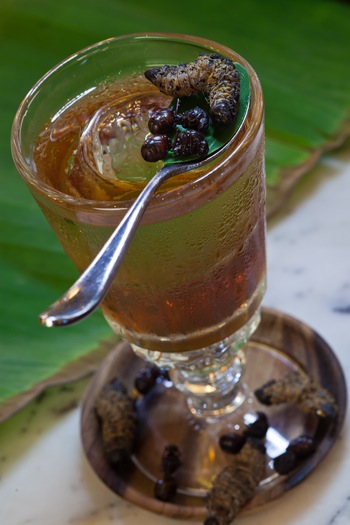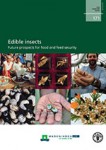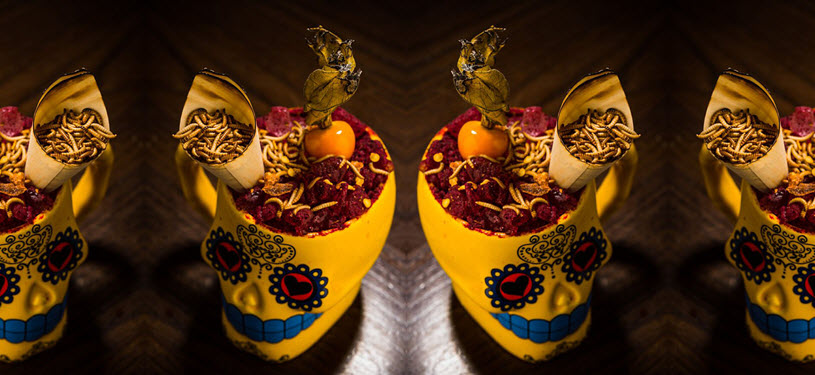
No more is the caliber of a cocktail bartender defined by the number of recipes they can recite but rather the unique ingredients and theater with which they deliver them. As a result terms like fat-washed, puree’d, foamed, dried, smoked, dehydrated and vacuum infused have allowed us to continually reinvent our favorite recipes behind a veneer of technical flatulence. A new age where cocktails are defined by their vessels, hand foraged ingredients and how many hits it can get when the image is shared online. And new aged drinks need new aged ingredients.
-
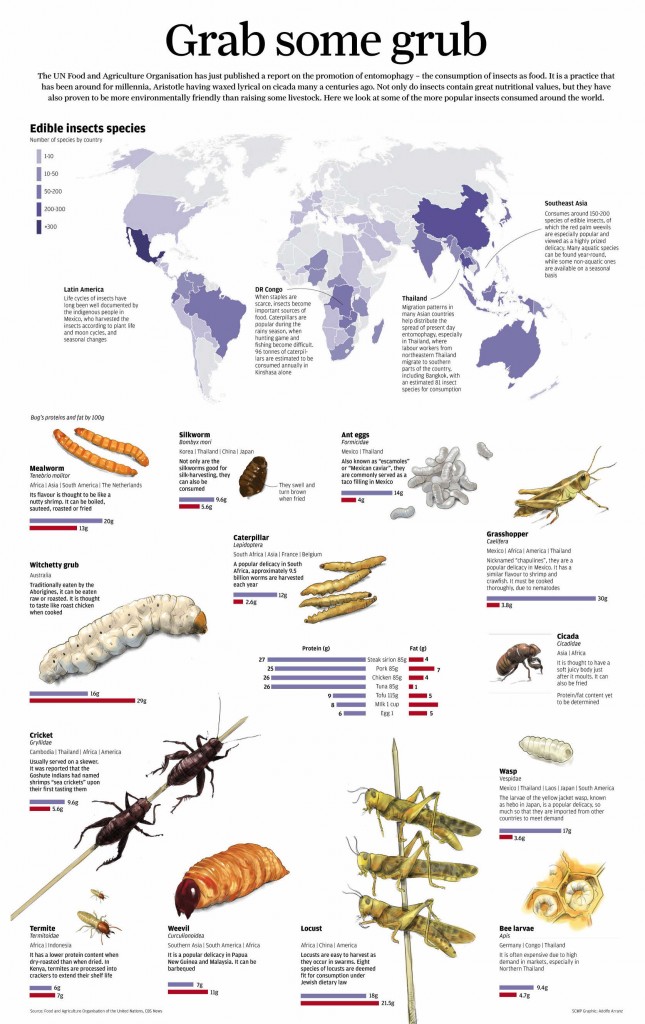
Edible bug infographic data from the UN’s report on the worlds most edible insect sources. Courtesy of The South Morning Post. Click image to enlarge.
It’s here then that I believe the future lies not in powdered alcohol or an army of evil robot bartenders name HAL but in the planets largest animal biomass – insects. Yes, bugs.
Officially defined as any invertebrate of the Phylum arthropoda with segmented body, jointed limbs and optional molting chitinous shell, insects can be more simply read as three-parts body (head, thorax and abdomen) to six parts of jointed legs with a dash of compound eyes and a garnish of antennae. Their total known extant species sits between 6 and 10 million different types which together represent over 90% of the total variety of animal life forms on the planet.
According to an article published by the Guardian Newspaper in 2010, over 1,000 species of insect are already known to be eaten in over 80% of the world’s recognized nations. Less surprising is the knowledge that the remaining 20% represent nations with the largest number of McDonald’s per head. But before we decry Ronald McDonald as the great defiler of arthropodial ingurgitation (I knew there was something dodgy about that freaky clown when I was little), it’s in flavor possibilities and not saving the world that we’re reading.
The conscious consumption of insects as part of a diet (liquid or solid) is officially referred to as ‘Entomophagy’ – the practive of eating insects; a term which includes the mutual consumption of arachnids (spiders) and myriapods (centipedes etc). And with over 6 million known species to choose from, the combined flavor variables equate roughly to 9.54 to the power of boat-loads. If we were to read a virtual shopping list to the world’s most imbibed bugs, it would represent everything from beetles, butterflies and moths to ants, bees, wasps, grasshoppers, crickets, cockroaches, termites and dragonflies. And while the majority of us physically react to the idea of ordering from the above list, here’s some further bug for thought.
Stay Informed: Sign up here for our Distillery Trail free email newsletter and be the first to get all the latest news, trends, job listings and events in your inbox.
According to the The Food Defect Action Levels as outlined by the FDA (US Food and Drug Administration), the following is a list of allowed bug fragments per volume of popular food groups. The insect fragments are classified as an aesthetic problem.
The Food Defect Action Levels states that these contaminants “pose no inherent hazard to health.”
[table “” not found /]But what’s really the big deal? The crispy crunch of bacon with a Cadbury Cream interior and more protein than…. Greek Yogurt. We flinch to chew a grilled grub but ask for two creamy eggs in our Full English Breakfast while ignoring their status as an excreted unfertilized developing embryo. Something which in human terms is defined as a ‘period’.
But enough of the guff. What are the real-life practical attributes to infesting our favorite classics with creepy crawlies? On the whole, insects tend to taste a bit nutty, largely due to the frying of their crispy exoskeletons. But again with at least 6 million species to choose from, there must be no shortage of potential flavor profiles to explore.
Here is some inspiration for ‘buggering up’ four of our most beloved recipes.
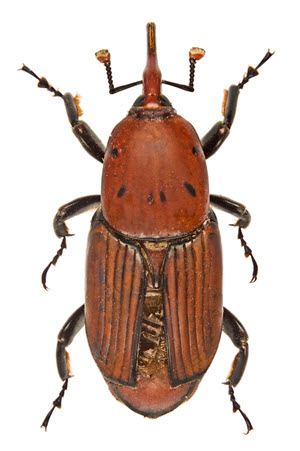
Bacon Flavored Manhattan: (Weevil)
Why bother with hours of fatwashing your favorite rye whiskey when all you need is a couple of Rhynchophorus ferrugineus. Commonly known as the Sago Palm Weevil, these plump yellow and cream colored bugs take on a remarkably bacon flavor with an added creamy nuttiness when roasted in butter.
Bloody Mary: (Scorpion)
Enhance your perfect Red Snapper recipe with a snapper of its own. Whether fried, roasted, grilled or baked, the common scorpion delivers a taste very similar to that of a crab or lobster with a touch of bitterness. Just like their crustaceans cousins, the richest flavors can be found in the meaty tail and pincers… just make sure you cut off the stinger first.
Whisky Sour: (Ant)
With acetic acid, bicarbonate soda and Japanese yuzu fruit all old hat tricks used by bartenders to replace the sensation of tart in cocktails, the Amazon rainforest plays host to billions of Lemon Ants just waiting to be served up. Lemon not only in taste but also color, the Lemon Ant delivers rich citrus acids and aromas from a natural citronellal pheromone when threatened as part of a glandular chemical defense system.
Maitai: (Water Bug)
Commonly enjoyed in traditional cuisine throughout Thailand, Giant Water Bugs (aka ‘Indian toe-biters’) deliver a strong aroma of sweet flowery fruits when steamed or fried. Able to grow up to an impressive 12cm in length, when imbibed the bugs deliver rich salty tropical flavors of banana and melon perfect for any tiki punch.
As fun as these recipes might be, your biggest task rests in how to inspire fervent interest in your regular punters rather than a gag reflex. Thankfully two of my favorite joints have shined the light for the rest of us.London’s legendary cocktail bar Nightjar recently launched their new summer drinks menu which included the ‘Inca Cocktail’. A huge recipe listing 1800 blanco Tequila, hazelnut oil, tomatillo & tonka puree, fino sherry, chilli wine, lime juice, agave syrup, epazote (Mexican tea leaf) and buffalo worms.
But showing why they’ve won more international awards than any other bar in history, The Artesian at The Langham Hotel in London have been using insects in some of their recipes as far back as 2010. The ‘Langham Tea Punch’ comprises of Courvoisier VSOP cognac, Japanese sencha tea, Poire William eau de vie, bitters, freshly squeezed lemon juice, mandarin peel and Velvet Falernum infused with oven-baked tarantula and scorpion. Or you can try their twist on a ‘Vieux Carre’ pairing cognac and rye whiskey with a side of toasted Colombian giant ants and Mopani worms.
The kitchen of the future will not be shut down for the discovery of a nesting family of cockroaches but subsidized for their contribution to global sustainability. While from a practical point-of-view, bugs are easier to grow on a backbar than basil, provide a natural source of essential carbohydrates, proteins, fats and vitamins and make for the coolest garnishes your drinks have ever seen. Moreover insects offer limitless potential for new flavor matches while delivering a whole new family of potential puns when trying to invent new and witty drink names.
‘Dune Bug’ anyone?
This was the Musings of a Barfly by: Rusty Hawthorn
If you are really bugging out now and want to learn more, check out this detailed report by the Food and Agriculture Organization of the United Nations. It’s called, Edible Insects Future Prospects for Food and Feed Security.


